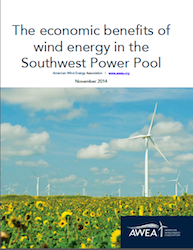According to a study recently released by the American Wind Energy Association (AWEA),  wind energy provides the Southwest Power Pool Region (SPP) with $2.8 billion in societal benefits per year. In 2013, wind energy accounted for 10.8 percent of the electricity produced in this region.
wind energy provides the Southwest Power Pool Region (SPP) with $2.8 billion in societal benefits per year. In 2013, wind energy accounted for 10.8 percent of the electricity produced in this region.
“The economic benefits of wind energy in the Southwest Pool” looked at the effect of wind energy in Kansas, Oklahoma and Nebraska as well as parts of New Mexico, Texas, Arkansas and Missouri. The study found that one MWh (megawatt hour) of wind energy in SPP, enough to power an average home for one month, provides an average of $109 in economic benefits to society and $7 in benefits to consumers.
The report found four major societal benefits:
- Wind reduces the cost of producing electricity. Wind energy is a zero-fuel cost so when utilities use the least-cost power plant first electricity produced from sources such as wind are tapped first.
- Wind energy reduces pollution. The reports notes that pollution from fossil-fired power plants, that are shown to harm health, are not currently reflected in electricity market prices. Wind reduces the costs to society in terms of pollution including no production of sulfur dioxide, smog-forming nitrogen oxides and greenhouse gases.
- Wind energy hedges against fuel price volatility. Wind energy helps to hedge against price volatility because unlike fossil fuels, wind energy is sold at a long-term fixed price through a Power Purchase Agreement.
- Fixed-priced wind energy becomes an even better deal as other fuels increase in price over time. Nearly all of wind plant’s costs are fixed up front and the majority of prices are fixed through the PPA. In contrast, the cost of conventional generation changes significantly based on fuel costs. These costs are passed along to consumers.
The report also cites two major benefits:
- Wind energy protects consumers by reducing use of the most expensive power plants. Because wind energy has a low production marginal cost because it has zero-fuel costs it drives down the market price for all electricity that is being purchased in the market.
- Fixed-price wind energy reduces consumer prices more as other fuels get more expensive. Fossil fuel prices are expected to increase whereas wind energy is a fixed price and the savings are passed along to consumers.
The report concludes that due to a drastic decline in wind energy adding new wind generation to the SPP will result in significant societal and consumer benefits.

